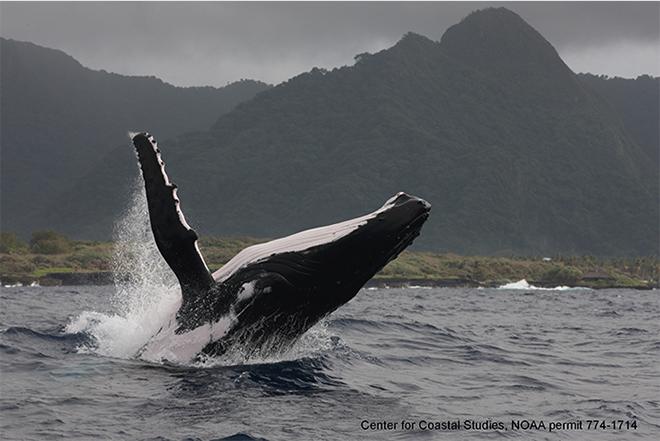Whale research - new techniques expand for non-lethal methods
by FishingBoating-World on 29 Jun 2014

A humpback whale breaches off American Samoa, a study site in the South Pacific. One of the sources of samples in this study was skin shed by breaching whales - Woods Hole Oceanographic Institution (WHOI)
http://www.whoi.edu/
We all love to see a whale off the bow, but the the Japanese Government maintains that you have to kill a whale to do scientific research. Scientific institutions world wide disagree. A routine method has been collecting samples which were obtained from biopsy-collecting-darts that bounce off the whales' skin. Non-lethal research tools continue to expand with scientists from Stanford's Center for Ocean Solutions proposing a new technique.
The International Court of Justice - in March 2014 ordered a temporary halt to Japan's Antarctic whaling program, ruling that it is not for scientific purposes as the Japanese government had claimed.
The Japanese had maintained that lethal methods, that is explosive harpoon grenades were needed to gather data on age and stomach contents and are planning to resume 'scientific whaling' next southern hemisphere summer.
However, there are now a range of non-lethal alternatives for data collection.
The criticism of Japan's research program which the court obviously agreed with was that the lethal research had not answered any meaningful questions in relation to the IWC's objectives, and that was a 'lack of testable hypotheses or performance measures'.
The 2013 Scientific Committee report stated 'that the special permit programs conducted by the Government of Japan...have not provided results relevant to the IWC and are unnecessary for the conservation and management of whales.'
Sollecting samples obtained from biopsy collecting darts that bounce off the whales' skin but important information can also be obtained from skin that naturally sloughs off when whales breach. Detailed population studies in these areas provided important details about the individuals involved, such as their age class and sex.
Now the range of non-lethal research tools continues to expand with scientists with Stanford's Center for Ocean Solutions propose to use genetic techniques as a low-cost, quick way to collect near real-time knowledge of marine environmental conditions.
In a paper published in Science today, scientists from Stanford's Center for Ocean Solutions, the University of Washington and the University of Copenhagen propose employing emerging environmental DNA (eDNA) sampling techniques that could make assessing the biodiversity of marine ecosystems – from single-cell critters to great white sharks and whales– as easy as taking a water sample.
Genetic monitoring via a form of DNA, known as eDNA, that is shed into the environment by animals could overcome some of these issues.
eDNA is like a fingerprint left at a crime scene. This material may come from metabolic waste, damaged tissue or sloughed off skin cells. Once it is collected, scientists can sequence the DNA to create a fast, high-resolution, non-invasive survey of whole biological communities.
'The eDNA work is potentially a game-changer for environmental monitoring,' said Larry Crowder, a professor of biology at Stanford's Hopkins Marine Station, senior fellow at the Stanford Woods Institute for the Environment, science director at the Center for Ocean Solutions and a co-author of the study. 'A number of laws require monitoring, but actually keeping tabs on large, mobile, cryptic animals is challenging and expensive.'
The cost of DNA sequencing is decreasing rapidly, a trend that has fueled eDNA studies in recent years.
'We wanted to know how to put these amazing new genetic tools to use,' said lead author Ryan Kelly, an assistant professor at the University of Washington and a visiting fellow at the Center for Ocean Solutions. 'Harnessing eDNA is a perfect example of how cutting-edge science can plug into many of the environmental laws we have on the books.'
If you want to link to this article then please use this URL: www.sail-world.com/123864